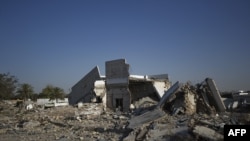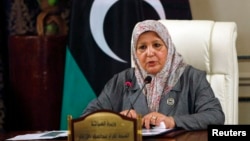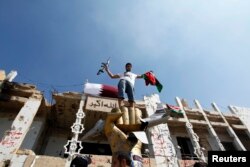TRIPOLI —
Moammar Gadhafi's Tripoli compound, the city within a city from which he orchestrated eccentric defiance of Western powers and disdain for his own people for four decades, is to be turned into a public park, Tourism Minister Ikram Abdusalam Bash Imam said on Tuesday.
The sprawling six-sq-km (2.5-sq-mile) Bab al-Aziziya complex once housed a swimming pool, sports pitches, senior officials' villas and gardens as well as an underground bunker, government offices and buildings belonging to the feared and pervasive security apparatus.
Some residents recall how they were too scared to look at it when they drove past to avoid harassment by security agents. But the revolution that toppled Gadhafi reduced it to rubble.
“We will soon start moving the debris from Bab al-Aziziya as well as conducting a security scan of the area,” Imam told a news conference. “Bab al-Aziziya will be an area of greenery and we hope to start seeing the first signs of this project in two months.”
The complex was first bombed by U.S. jets in 1986 in retaliation for the Libyan bombing of a discotheque in Berlin - but finally pulverized in August 2011 when NATO warplanes bombed it to help rebels to seize control of the capital.
Rebel fighters poured in, smashing statues, burning Gadhafi's Bedouin-style tents and seizing weapons; the names of the brigades who captured the compound are still commemorated in graffiti sprayed all over the walls.
Within hours, ordinary Libyans also flooded through the once forbidding high concrete walls to inspect the villas, loot flat-screen televisions or simply gloat over Gadhafi's fall.
A statue of a golden fist crushing a fighter jet, erected by Gadhafi outside a building bombed in 1986 that he dubbed the “House of Resistance”, was moved to the coastal town of Misrata, which withstood a three-month siege by Gadhafi's forces.
A few dozen families later moved into the buildings still standing among the huge piles of rubble, but increasingly they share Bab al-Aziziya, whose name means “Splendid Gate”, with Tripoli's accumulating municipal waste.
Imam said the families living in Bab al-Aziziya would be moved to new housing after the fasting month of Ramadan, currently under way.
However, the park's long-term future is far from certain in a still-chaotic country run by a weak transitional administration.
“Bab al-Aziziya will remain a park until there are definite plans for the city,” Imam said.
The sprawling six-sq-km (2.5-sq-mile) Bab al-Aziziya complex once housed a swimming pool, sports pitches, senior officials' villas and gardens as well as an underground bunker, government offices and buildings belonging to the feared and pervasive security apparatus.
Some residents recall how they were too scared to look at it when they drove past to avoid harassment by security agents. But the revolution that toppled Gadhafi reduced it to rubble.
“We will soon start moving the debris from Bab al-Aziziya as well as conducting a security scan of the area,” Imam told a news conference. “Bab al-Aziziya will be an area of greenery and we hope to start seeing the first signs of this project in two months.”
The complex was first bombed by U.S. jets in 1986 in retaliation for the Libyan bombing of a discotheque in Berlin - but finally pulverized in August 2011 when NATO warplanes bombed it to help rebels to seize control of the capital.
Rebel fighters poured in, smashing statues, burning Gadhafi's Bedouin-style tents and seizing weapons; the names of the brigades who captured the compound are still commemorated in graffiti sprayed all over the walls.
Within hours, ordinary Libyans also flooded through the once forbidding high concrete walls to inspect the villas, loot flat-screen televisions or simply gloat over Gadhafi's fall.
A statue of a golden fist crushing a fighter jet, erected by Gadhafi outside a building bombed in 1986 that he dubbed the “House of Resistance”, was moved to the coastal town of Misrata, which withstood a three-month siege by Gadhafi's forces.
A few dozen families later moved into the buildings still standing among the huge piles of rubble, but increasingly they share Bab al-Aziziya, whose name means “Splendid Gate”, with Tripoli's accumulating municipal waste.
Imam said the families living in Bab al-Aziziya would be moved to new housing after the fasting month of Ramadan, currently under way.
However, the park's long-term future is far from certain in a still-chaotic country run by a weak transitional administration.
“Bab al-Aziziya will remain a park until there are definite plans for the city,” Imam said.











